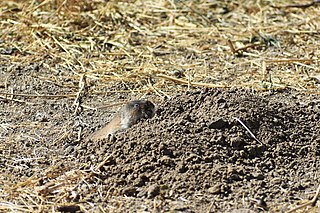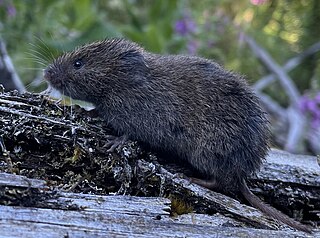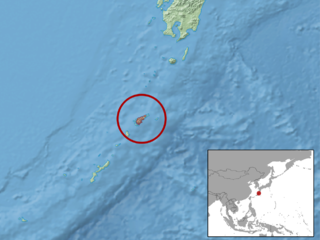
The Y chromosome is one of two sex chromosomes in therian mammals and other organisms. Along with the X chromosome, it is part of the XY sex-determination system, in which the Y is the sex-determining chromosome because the presence of the Y chromosome causes offspring produced in sexual reproduction to be of male sex. In mammals, the Y chromosome contains the SRY gene, which triggers development of male gonads. The Y chromosome is passed only from male parents to male offspring.

Voles are small rodents that are relatives of lemmings and hamsters, but with a stouter body; a longer, hairy tail; a slightly rounder head; smaller eyes and ears; and differently formed molars. They are sometimes known as meadow mice or field mice.

The Arvicolinae are a subfamily of rodents that includes the voles, lemmings, and muskrats. They are most closely related to the other subfamilies in the Cricetidae. Some authorities place the subfamily Arvicolinae in the family Muridae along with all other members of the superfamily Muroidea. Some refer to the subfamily as the Microtinae or rank the taxon as a full family, the Arvicolidae.

Tokudaia is a genus of murine rodent native to Japan. Known as Ryūkyū spiny rats or spinous country-rats, population groups exist on several non-contiguous islands. Despite differences in name and appearance, they are the closest living relatives of the Eurasian field mouse (Apodemus). Of the three species, both T. osimensis and T. tokunoshimensis have lost their Y chromosome and SRY gene; the sex chromosomes of T. muenninki, on the other hand, are abnormally large.
The Alai mole vole is a species of rodent in the family Cricetidae. It is known only from Kyrgyzstan, where it has been found in temperate grassland in the Alai Mountains. Little else is known about the vole.
The southern mole vole is a species of rodent in the family Cricetidae. It is found in Afghanistan, Iran, Pakistan, and Turkmenistan.

The Transcaucasian mole vole is a species of rodent in the family Cricetidae.

The northern mole vole is a species of rodent in the family Cricetidae. It is distributed over large parts of Eastern Europe and Asia.

The Zaisan mole vole, or eastern mole vole, is a species of rodent in the family Cricetidae. It is found in central Asia.

The creeping vole, sometimes known as the Oregon meadow mouse, is a small rodent in the family Cricetidae. Ranging across the Pacific Northwest of North America, it is found in forests, grasslands, woodlands, and chaparral environments. The small-tailed, furry, brownish-gray mammal was first described in the scientific literature in 1839, from a specimen collected near the mouth of the Columbia River. The smallest vole in its range, it weighs around 19 g. At birth, they weigh 1.6 g, are naked, pink, unable to open their eyes, and the ear flaps completely cover the ear openings. Although not always common throughout their range, there are no major concerns for their survival as a species.

The Ryukyu spiny rat is a species of rodent in the family Muridae. Endemic to Amami Ōshima island in the Amami Islands of the Ryukyu archipelago of Japan, its natural habitat is subtropical moist broadleaf forest. The karyotype has an odd diploid number, 2n = 25. Like its relative T. tokunoshimensis, it has lost its Y chromosome and SRY gene.

Ellobiusini is a tribe of voles containing two genera: Ellobius and Bramus. All extant taxa in this tribe were formerly included in the genus Ellobius. These species are distinguishable from most other voles in that they are highly fossorial, resembling the blesmols and spalacids more than other voles. The long-clawed mole vole is unrelated to these species. The nomenclature of this tribe is unresolved but may be changed to Bramina. "Ellobiusini" may be preoccupied by a tribe of snails in the family Ellobiidae.

The Tokunoshima spiny rat is a rodent found only on the island of Tokunoshima in the Satsunan Islands of Japan. Due to its small habitat, it is considered endangered. It is commonly found in the secondary and primary subtropical moist broadleaf forests of this island. The karyotype has an odd diploid number, 2n = 45. Like its relative T. osimensis, it is one of the few mammals that lack a Y chromosome and SRY gene.

Bramus is a genus of fossorial rodents. It formerly contained only the extinct North African species Bramus barbarus. Both species in Bramus were moved to this genus from Ellobius. They differ from Ellobius in being larger, having a distinct sagital crest, and other features of the teeth and skull. They also occur allopatrically from Ellobius. They are sexually dimorphic, with females being larger than males. The genus comprises two extant species:


















